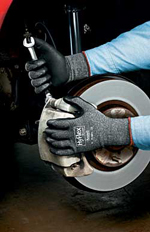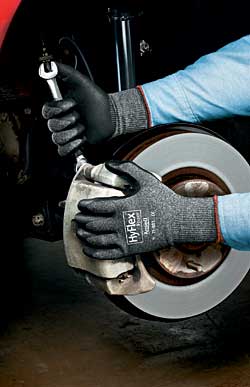
Frequently Asked Questions: Ergonomics and Hand Protection
When the hands become fatigued, often the entire body experiences fatigue, which reduces productivity. Awkward, painful postures are another concern.
- By Michael S. Zedalis, Keitha Kessler
- Apr 12, 2007
 SOARING medical costs and production losses resulting from repetitive motion
injuries and related musculoskeletal disorders, including carpal tunnel
syndrome, are inciting safety personnel to rapidly advance their consideration
of ergonomically designed products that can reduce these types of injuries.
Below are answers to common questions related to ergonomics and hand protection
products--their safety, performance, quality improvements, and cost
advantages.
SOARING medical costs and production losses resulting from repetitive motion
injuries and related musculoskeletal disorders, including carpal tunnel
syndrome, are inciting safety personnel to rapidly advance their consideration
of ergonomically designed products that can reduce these types of injuries.
Below are answers to common questions related to ergonomics and hand protection
products--their safety, performance, quality improvements, and cost
advantages.
Why is it becoming increasingly important to use hand protection products
with an ergonomic design?
Individuals who do not use the proper hand
protection for a specific task may end up working in an unsafe manner.
Ergonomically designed hand protection can maximize worker protection while
increasing productivity, with the added benefit of reducing hand fatigue. Gloves
made of cut-resistant yarns, for example, can be formed to the natural shape of
the hand to enhance a worker's movement, allowing the hands to bend and the
fingers to flex more freely.
Comfort may be linked to the gloves' ability to protect from heat or cold,
manage moisture (perspiration), hydrate the skin, and enhance the skin's
elasticity.
Workers handling parts in an auto body or boat assembly operation, for
instance, must be able to grip small, oily parts without exerting extra force.
When a worker does not have a secure wet grip, the person may change his or her
posture to compensate or place more stress on the muscles and joints than would
be necessary if the grip were adequate. This situation could indirectly lead to
back injury or a musculoskeletal disorder such as carpal tunnel
syndrome--especially if the worker is performing the task repeatedly.
Why are ergonomically designed hand protection products more in vogue now
than in the past?
As with everything else, the
demands on hand protection products are increasing. Companies and their workers
have more requirements related to their safety programs and hand protection
products than ever before. More stringent OSHA regulations and a growing number
of lawsuits require employers to provide safe equipment and a safe working
environment. Most manufacturers monitor lost time work injuries and consider
them a serious issue in terms of employee welfare and the bottom line. Employers
want to know whether the hand protection products and safety equipment they are
providing benefit workers in terms of safety and productivity.
What are some features I should look for in ergonomically designed
gloves?
Beyond protection, fit and feel (comfort) are always essential.
If the gloves do not fit like a second skin and allow maximum flexibility, then
other ergonomic benefits will have a smaller performance impact. Proper fit and
comfort are especially important for workers who suffer from arthritis or may
not have greater levels of muscle strength.
Gloves that are too small may restrict movement and blood flow and lead to
cramping, hand fatigue, and perspiration. When the hands become fatigued, often
the entire body experiences fatigue, which reduces productivity. Gloves that are
too large and bulky decrease a worker's dexterity and may result in the worker's
straining to perform the required tasks. Gloves that are too large also can pose
a safety hazard for individuals who are working near equipment with moving parts
or pinch points.
Glove comfort, however, goes beyond fit. Depending upon the application,
comfort may be linked to the gloves' ability to protect from heat or cold,
manage moisture (perspiration), hydrate the skin, and enhance the skin's
elasticity. Gloves should also be easy to put on and take off, which will reduce
stress and strain on muscles and joints, as well as the time needed to don and
doff the product.
In some cases, having an adequate level of cut protection may be considered
an ergonomic benefit. If a worker must handle a knife or sharp glass and is
fearful of receiving a cut injury, for example, he or she may grip the object
tighter than necessary, which results in increased stress, strain, and hand
fatigue. In situations where grip is inadequate, the risk of cuts may
increase.
Are ergonomically designed hand protection products more critical for
specific jobs in certain industries?
Absolutely. Just as different
products offer the safety features required for certain applications (e.g., cut
resistance for glass handling and insulation for workers performing tasks in
cold environments), gloves with tailored ergonomic features are better suited
for specific tasks.
In most instances, a glove's ergonomic features will be combined with
other performance/safety characteristics that are required for the application.
In most instances, a glove's ergonomic features will be combined with other
performance/safety characteristics that are required for the application. In an
auto body assembly operation, for example, workers will need gloves with cut
resistance because they are handling trimmed steel with sharp edges. They also
will require the dexterity and tactile sensitivity needed to position small
nuts, bolts, washers, and screws in the steel sheet. Because the materials
handled are often coated with a fine layer of oil, workers will need gloves with
oil resistance and a wet grip. If parts are being welded into place, the gloves
also must provide heat protection.
Why are ergonomically designed gloves so critical for workers within the
chemical industry?
Because workers within the chemical industry are
constantly handling hazardous materials, they must have the dexterity and
tactile sensitivity to feel and safely handle equipment and containers,
including small glassware. Workers also should be able to freely move their
hands and work for extended periods of time without experiencing cramping and
hand fatigue.
For many tasks within processing and production plants--whether workers are
processing chemicals or using chemicals for production tasks, such as appliance
assembly--the first priority is to protect workers' hands from chemicals and
prevent permeation. Yet, workers still will need enough tactile sensitivity,
dexterity, and wet grip to handle chemicals and equipment safely.
Flexibility is also important because many tasks within chemical processing
and refining plants and manufacturing facilities are repetitious. With today's
glove production technology, all of these performance characteristics are
possible and provide measurable results in terms of safety, productivity, and
comfort.
What ergonomic factors should be considered when selecting hand protection
for workers handling harsh or hazardous chemicals?
Again, an appropriate
level of protection from the chemicals being handled is number one. And, as
mentioned above, proper sizing is a must. An easy on/off design is also a
priority so workers can put the gloves on and take them off without making
contact with the outside contaminated surface.
Gloves also must be appropriate for the task and provide the grip and
dexterity required. Fingertip design is a consideration for applications in
which workers must handle glass and small parts, such as test tubes and beakers.
The fingertips of many gloves are conical-shaped and larger than a human
fingertip, which decreases tactile sensitivity and results in sloppiness.
Technology used by some glove manufacturers allows the fingertips to be
form-fitted for greater tactility. The choice of materials is important, with
nitrile, neoprene, natural rubber, some knitted yarns and rubber-coated knitted
liners more conducive to a good fingertip design. Unsupported gloves are usually
more appropriate for chemical applications than supported gloves; today's best
gloves utilize the most chemically resistant materials and are designed to be
lightweight, enhance dexterity, and conform to the hand and fingers.
What are some of the consequences of not wearing ergonomically designed
hand protection?
A higher risk of injury is always present; a worker
performing a task without proper hand protection is comparable to a person using
the wrong tool for a job such as maintenance. Reduced quality and lower
productivity are other consequences because precision may be lost and there is
often a lack of repeatability.
There is significant economic value in preventing physical problems such as
back injuries, carpal tunnel syndrome, and nerve damage. Companies also can gain
by improving productivity. For example, more parts can be produced per hour if
workers wear gloves that provide a better grip or tactile sensitivity and reduce
hand fatigue.
Ergonomically designed products also can reduce costs associated with poor
product quality. If, for example, a worker does not have the tactile sensitivity
needed to precisely position a nut or thin metal washer on a piece of trimmed
steel so a mating part matches up with the hole, the part may later require
costly re-work. Such tasks must be repeatable over a work shift and across
thousands of pieces produced. Six Sigma goals indicate only six defects are
acceptable per million parts, which means only six nuts or holes can be
misaligned in a million assemblies!
How do I know whether hand protection products are designed with
ergonomics in mind?
Ergonomic benefits should be communicated as part of
a product's value proposition. If the value proposition is only about cut or
chemical protection, for example, you probably can assume the ergonomics of the
user were not considered when the gloves were designed and manufactured.
Ergonomic benefits should be clearly stated in all product marketing materials
and literature. The buyer should also ask, "What ergonomic benefits will your
products provide?"
At this time, only a handful of glove manufacturers are focusing on
ergonomics as part of their product design and manufacturing process. This is
likely to change, however, as more users request gloves with ergonomic features
that offer measurable safety and productivity advantages.
This article appeared in the April 2007 issue of Occupational Health &
Safety.
This article originally appeared in the April 2007 issue of Occupational Health & Safety.